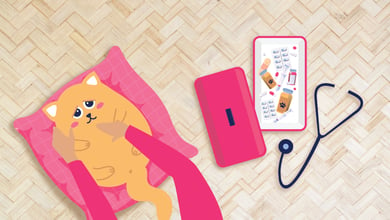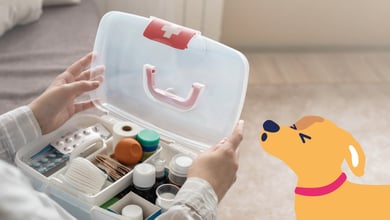Preparing Your Pet for Daycare or Boarding [Printable Checklist]

You've planned the perfect getaway, but your itinerary doesn’t stop there; you also need to think about arranging care for your furry family members.
Whether you're considering doggie or kitty daycare for a fun day out or a pet boarding facility for a longer vacation, making sure your pet is prepared ahead of time is the key to a stress-free experience for everyone.
This guide will help you pack like a pro for your canine and feline companions. We’ve included a helpful checklist for both dogs and cats to ensure they can stick to their routine and have everything they need for a happy and healthy stay!
🔑 Key Takeaways
- Choose a reputable daycare or boarding facility with experienced staff and a clean, secure environment
- Schedule a wellness exam for your pet before their daycare or boarding visit.
- Up-to-date vaccinations and parasite prevention ensure a healthy stay for your pet and fellow furry guests.
- If you will not be accessible by phone or email make sure someone you trust is available to receive communication and make decisions on your behalf.
Choosing a Reputable Pet Boarding Service or Daycare Facility
Leaving your pet in someone else's care can be nerve-wracking for us pet parents. With a little research and consideration, you can find a daycare or boarding facility that offers a safe, stimulating, and comfortable environment for your pet.
Here are some criteria to help you choose a pet boarding or daycare facility:
Licensing and Insurance
Make sure the daycare or boarding facility is properly licensed by your state or local municipality and carries the appropriate pet liability insurance.
Reviews
Research what other pet parents are saying about the facility on Yelp, Google, Trustpilot, and social media.
Cleanliness and Safety
The facility should be clean, well-maintained, and smell fresh. Secure fencing, separate play areas for different-sized dogs (if applicable), and proper ventilation are all features to look for or inquire about.
Staff Qualifications
Look for information about the experience and training of caregivers. Ideally, they should be certified in pet CPR and first aid.
Meet and Greet
Schedule a tour of the facility before your pet's stay. This will allow you to observe staff-pet interactions, ask questions, and ensure the overall environment feels like a good fit for your pet's needs and personality.
Are You a Pet Safety Expert?
1. Which one of the plants below is toxic to cats if ingested?
2. Which of the foods below is generally considered safe for your dog to eat?
3. Above what temperature is too hot to leave a pet in your car?
4. Which kind of leash is the safest to walk your dog?
5. True or False: If a medication is safe for humans, it is probably safe for pets.
6. What should you do if you think your pet ate something toxic?
View Results
Are You a Pet Safety Expert?
1. Which one of the plants below is toxic to cats if ingested?
2. Which of the foods below is generally considered safe for your dog to eat?
3. Above what temperature is too hot to leave a pet in your car?
4. Which kind of leash is the safest to walk your dog?
5. True or False: If a medication is safe for humans, it is probably safe for pets.
6. What should you do if you think your pet ate something toxic?
Share Quiz
Communication and Updates
Find out how the facility will keep in communication with you. Will you receive daily reports or have access to webcams? How will they handle any changes in your pet's behavior or health?
Pet Boarding Checklist
Now that you've chosen a reputable daycare or boarding facility, it's all about making sure your pet feels happy and secure during their stay.
Our checklist will guide you through everything your furry family members need for their home away from home.
1. Vaccinations and Veterinary Records
Ensure your pet's vaccinations are up-to-date. Double-check with the facility for any additional requirements, and bring a copy of your pet's veterinary records for their stay.
2. Parasite Prevention
Administer a veterinarian-recommended flea and tick preventative medication to your pet before their stay. This helps safeguard your pet and other furry friends at the daycare or boarding facility. Some facilities may require a fecal analysis to screen for internal parasites before their stay.
3. Recent Wellness Exam
Schedule a wellness checkup with your veterinarian within 1 to 3 months of your pet's daycare or boarding visit. This will ensure your pet is healthy and receives any preventative medication before their stay.
4. Food and Feeding Schedule
Pack enough of your pet's usual food for their stay. Include a labeled container with clear feeding instructions detailing amounts and times to maintain their routine.
5. Medications and Supplements (if applicable)
If your pet requires any medications or supplements, pack them for the duration of their stay along with written instructions on dosage and administration schedule. Be sure to include details like whether the medication should be given with or without food.
6. Favorite Toys
Pack a few of your pet's favorite toys or stuffed animals. Familiar items will provide comfort and entertainment during their stay. However, check with the facility regarding any restrictions on toys in shared play areas.
7. Treats from Home
Pack a small bag of your pet's favorite treats. Let the caregivers know the right amount for your pet to avoid overfeeding.
8. Bedding and Comfort Items
Send your pet with a comfy blanket or bed that smells like home. This familiar scent can provide a sense of security and promote restful sleep during their stay.
*Bonus Tip: Include a favorite t-shirt of yours for your pet to cuddle up with.
9. Food and Water Bowls
While many facilities provide food and water bowls, you can check with the daycare or boarding facility if they recommend bringing your own for your pet's comfort and routine.
10. Litter Box and Litter
Find out if the facility provides litter boxes and litter. If your cat has a preference for a specific type of litter, be sure to check with the facility if they allow you to bring your own.
11. Emergency Contact Information
Provide the facility with your contact information and that of an additional friend or family member who can be reached in case of emergency.
Download your printable checklist here!
Conclusion
With a little planning and preparation, you can have peace of mind knowing your pet has everything they need for a successful stay at daycare or a boarding facility. By following our checklists and choosing a reputable provider, you can enjoy your trip or work day knowing your furry family member is in good hands.
Stress-Free Vaccinations for Your Furry Friend
Get your pet vaccinated in their favorite spot - at home. No need to hassle with carriers or car rides.
Frequently Asked Questions
What is pet boarding?
Pet boarding is a service provided for pet owners who need a temporary place for their pets to stay while they are away from home.
How to pack dog food for boarding?
Make sure to pack enough dog food for each meal while you are away. Consider separate well-sealed containers for each meal for easy administration. Include instructions on the amount of food per meal, your pet’s meal times, and any restrictions or special dietary requirements.
What do dogs do all day in boarding?
Daily activities can vary depending on the type of boarding service. Most reputable boarding facilities offer a structured schedule to keep your dog engaged, comfortable and well-cared for.
Examples include scheduled exercise or playtimes, time for rest, social interaction with humans and other dogs, and regularly scheduled potty breaks.
What to expect when your dog comes home from boarding?
Dogs may react differently based on their personalities and experience. Excitement, tiredness, restlessness, and change in routine are a few examples of behaviors your dog may exhibit when returning home.
What are the disadvantages of pet boarding?
Ensuring your pet is staying at a reputable boarding facility will eliminate most disadvantages of pet boarding. Some pets may experience stress being in an unfamiliar environment. Boarding facilities can be costly at times but cutting costs may not be beneficial for your pet. If your pet is easily stressed or anxious when away from home, consider pet sitters or family members who can stay in your home while you are away.






